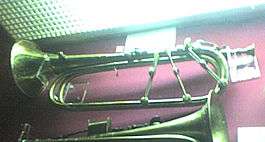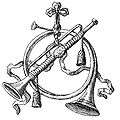Keyed trumpet
The keyed trumpet is a brass instrument that makes use of keyed openings in its bore rather than extensions of the length of the bore as the means of playing all the notes of the chromatic scale. The instrument's popularity reached its high-point around the turn of the nineteenth century; but it waned with the emergence of the valved trumpet in the early nineteenth century and it is rarely seen in modern performances. Prior to the invention of the keyed trumpet, the prominent trumpet of the time was the natural trumpet.
The keyed trumpet has holes in the wall of the tube that are closed by keys. The experimental E♭ keyed trumpet was not confined to the natural notes, but was chromatic in all registers of the instrument.[1] Before this, the trumpet was commonly valveless and could only play a limited range of “harmonic” notes by altering lip pressure. These harmonic notes were clustered in the high registers, so previous trumpet concertos could only play melodies at very high pitches.
There is also some discrepancy over who created the E♭ keyed trumpet, as it is claimed that “the Viennese court trumpeter, Anton Weidinger invented the keyed trumpet”[2] though elsewhere it is insisted that although “the invention of the keyed trumpet has been ascribed to the Viennese, Anton Weidinger, who is said to have constructed it in 1801... the instrument itself is older than that, as Haydn's concerto was written five years earlier.”[1]
Tone
Due to its physical characteristics (bore, bell, historical mouthpiece), the keyed trumpet is closer in tone to the natural trumpet than the valved trumpet. It was once said to have sounded like a "Demented Oboe... despite Haydn's efforts, the keyed trumpet had no real success- the explanation may be that the holes detracted from the brilliant tone of the instrument.”[1]
Concertos
J. Haydn – trumpet concerto
In 1796 Joseph Haydn wrote his Trumpet Concerto for Anton Weidinger and it was performed on 22 March 1800 at the Imperial and Royal Court Theatre. The piece begins with the broken triads and fanfare motifs common to trumpet music of the time (perhaps as a jibe to the audience who had come to see this exciting new kind of trumpet), but follows with chromatic runs and diatonic melodies not possible on the valveless natural trumpet.
The highest note in the Haydn trumpet concerto is high concert D♭, or high E♭ on a B♭ trumpet, or a high B♭ on E♭ trumpet for which it was written.
J. N. Hummel – trumpet concerto
Like Haydn, Johann Nepomuk Hummel wrote his Trumpet Concerto for Anton Weidinger. It was written and performed in 1803 to mark his entrance into the Esterházy court orchestra in 1804, following Haydn. There are places, primarily in the second movement, where Weidinger is believed to have changed the music because of the execution of the instrument. It is unknown whether this was in agreement with Hummel.
See also
- Natural trumpet for more information on the keyed trumpet's predecessor
- Piston valve for a description of more modern trumpets and how they work
- Trumpet for a more detailed history on the trumpets evolution through time
References
- Geiringer, K and Geiringer, I (1982) Haydn: A Creative Life in Music, p. 324-325
- Warburton, A (1867) Analyses of Musical Classics: Book 2. London, Spottiswoode, Ballantyre and Co Ltd
External links
- Keyed trumpets in the Joe R. and Joella F. Utley Collection of Brass Instruments at the National Music Museum
- thekeyedtrumpet.co.uk - a website dedicated to the keyed trumpet

